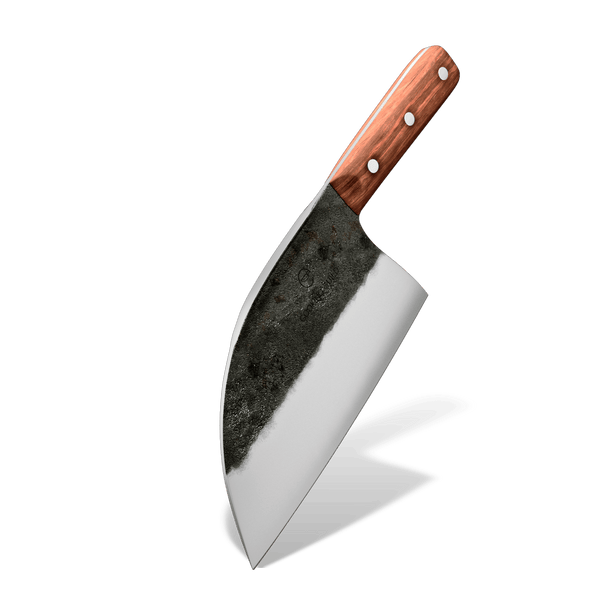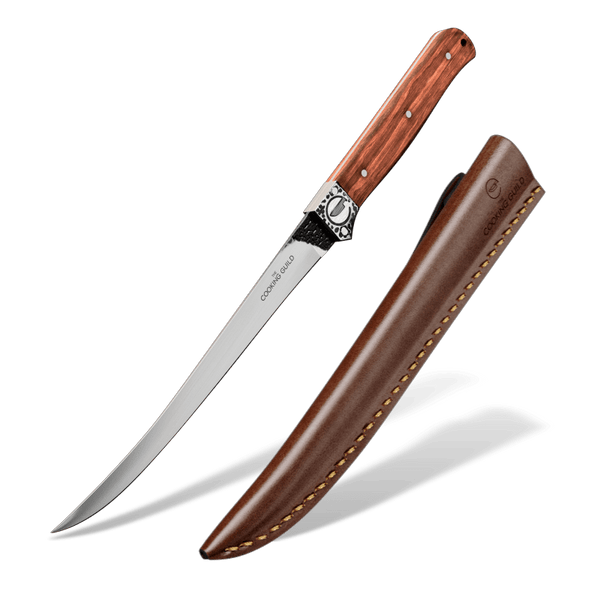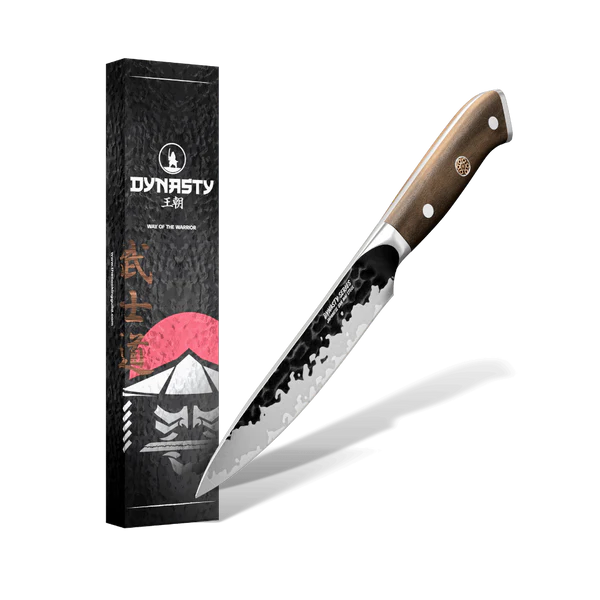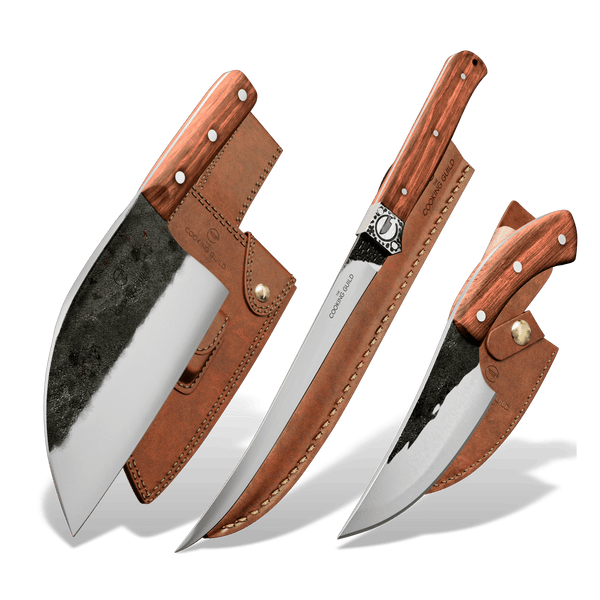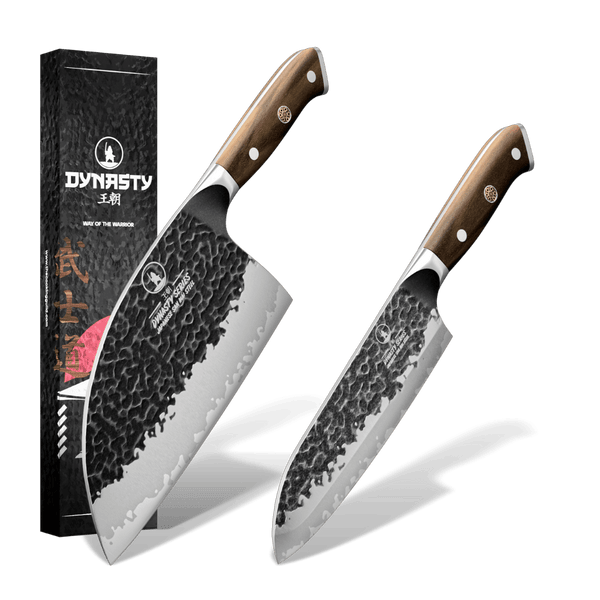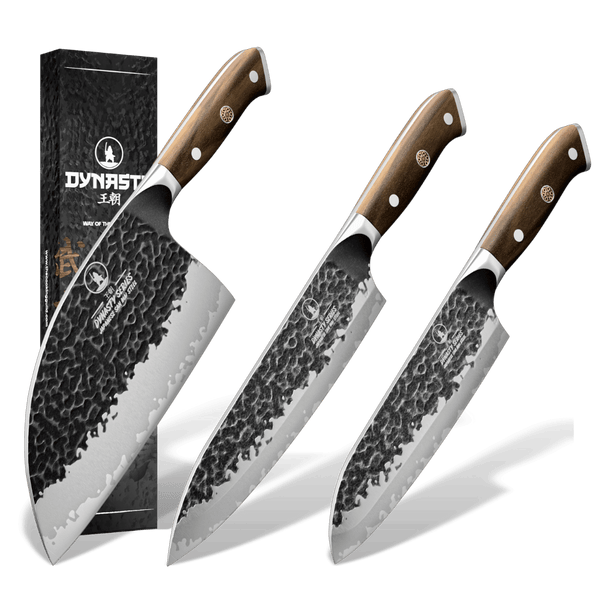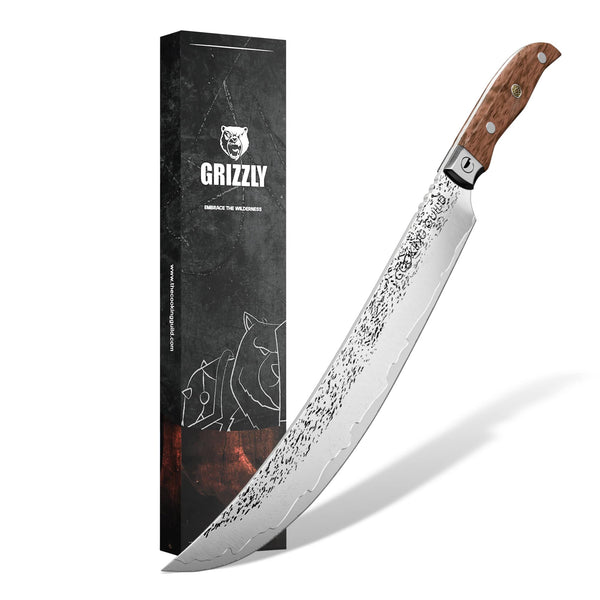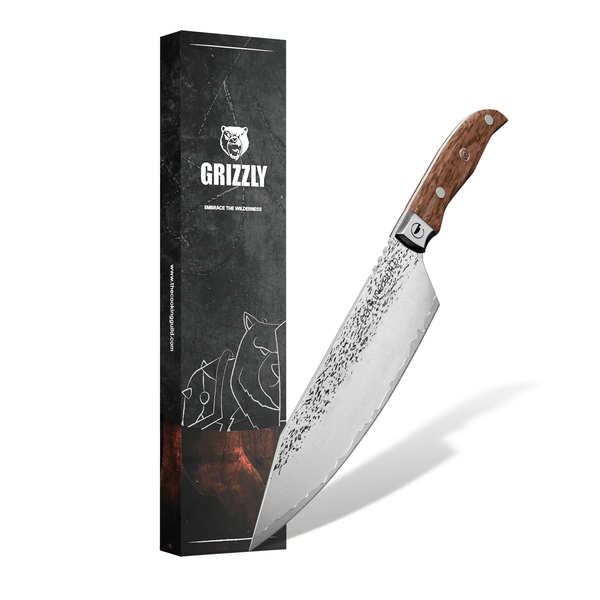Unlock a world of culinary artistry and precision with Damascus Steel Knives. Crafted through centuries-old techniques, these knives are the epitome of both form and function, blending exquisite aesthetics with unparalleled performance in the kitchen.
Elevate your cooking game to new heights as you wield these masterpieces of cutlery, each blade bearing a mesmerizing, distinctive pattern and an edge that promises unrivaled sharpness and durability. Whether you're a seasoned chef or a passionate home cook, the grace and power of Damascus Steel Knives will transform your culinary endeavors into a symphony of flavors and precision, making every dish a work of culinary art.
What Makes Damascus Steel Special?
Damascus Steel is known for having creative and artistic pattern-welded forges within the finished products. These are best seen on blades and knives, an exceptional combination of strength, sharpness, and striking aesthetics, making it a favored source for blades and knives.
Finest Blades Ever
Damascus blades are forged to meet aesthetics and functionality and are made to be the finest in providing excellent performances. Damascus blades are renowned for being extremely sharp, which allows precise and effortless cutting.
What Is Damascus Steel?
It is a forged alloy that is made with more than one layer of steel during forging. Historically, genuine steels were made using Wootz steel. Nowadays, they primarily consist of a blend of high-carbon content steel, carbide, and more pliable stainless steel.
Key Takeaways: Damascus Steel
This steel is commonly characterized by these specific features:
- Creative patterns that are carefully etched onto the blade/final product.
- Simple maintenance and inherently resistant to corrosion.
- A hardness range within 52-60 on the Rockwell scale for quality strength and resistance.

The Origins Of Damascus Steel Date To As Early As 1500 BC
The origins of these steel blades date back around 900 AD to 1750 AD, within the vicinity of Damascus, Syria. These steel alloys are rigid and flexible, making it favorable for blacksmiths to implement this kind of steel in swords and knife making.
Where Damascus Steel Gets Its Name
In the Syriac language, Damascus means “well-watered land,” where the capital of Syria has adopted its name. This capital is also renowned for where the first Damascus steel blades were forged and where it gets its name.
Who Made The First Damascus?
Unlike records confirming the location and date of and when these special alloys were forged, it is unclear who specifically made the first Damascus steel, as more than one Blacksmiths used these techniques in forging swords and knife-making at the time.
Staying True To The Steel’s Roots
The hallmark of the steel’s distinctive wave-like patterns continues to be implemented with modern-day forging and welding. Modern-day forgers implement these unique blade forging and replicate this ancient technique to maintain its authenticity.
Technological Advancements Of Damascus
Over recent years, technological advancements have expanded the in-depth understanding of metal forging. It helps individuals access a wide range of alloys and heating methods in replicating the original strength and sharpness of these ancient steel knives.
Does Real Damascus Steel Still Exist?
Wootz steel, the original metal used to make this ancient steel, is no longer existent nor produced. Traditional methods of forging Damascus patterns have been lost for a long time. Today, modern techniques of development replicate the traditional methods.
Which Damascus Steel Is The “Real” One
Due to the loss of the original techniques and materials to make this kind of authentic steel, these pattern-welded steel were considered lost by the 18th century. Today, these steel blades are broadly named for their pattern welding.
Despite the original method being lost, today’s modern techniques and materials have made several attempts with results closely replicating the appearance of historic Damascus steel.
What Is Modern Damascus Steel Usually Made Of
This modern steel has been replicated through modern forging methods, which came close in results in terms of aesthetics and performance assessment. These blades nowadays are made from layers of high carbon steel, which provides the blade with quality sharpness.
Why Is Damascus Steel So Expensive?
Damascus steel blades and knives are considered to be in an expensive range due to the factors that made these quality results. Skilled craftsmen have spent time and effort forging, layering, and finishing various steels.
Additional factors include special alloys used for the blades and the rarity and significance of the Damascus pattern contributing to the value.

Is Damascus Steel Actually Stronger?
It has been highly regarded to be a very strong metal when it is compared to other resilient materials such as high-carbon and regular carbon steel. Historically this kind of steel was referred to as the strong result of combining hardness and flexibility, one of the few reasons this steel was used in forging swords and bladed weapons at the time. This is why we love using Damascus Steel in our Damascus steel knives like our chef knife, cleavers, petty knives, fillet knives, and more!
The Various Patterns Of Damascus
This kind of steel has different ranges of patterns that highlight the craftsman's professional and creative factors. Here are some of the most popular Damascus patterns.
- Raindrop Pattern: This type of pattern resembles small, round shapes that give a similar appearance to its namesake.
- Wave Pattern: This pattern resembles flowing rivers or water ripples. It is considered one of the most common patterns for Damascus.
- Ladder Pattern: This pattern displays ladder-like formations that create parallel lines across the finished blade.
Cast Damascus Steel
This is an alternative alias of the wootz kind of steel and is a popular alloy and forging in the East. The process involves the fusion of iron and steel by utilizing charcoal in a reduced oxygen environment.
Pattern-welded Damascus Steel
This pattern-welded steel is created by joining layers of various steel types through forge welding. This results in the formation of intricate surface patterns, making it a highly desirable material for crafting high-end custom knives.
What Is Wootz Damascus
Wootz Damascus are the ancient and authentic variants of pattern-welded blades. Bands of cementite particles produce these as the blades and are forged from small ingots. This forging is done by heating the ingots in gas-fired furnaces and repeating folding forging.
Crucible Steel From Other Places, Maybe
The origin of crucible steel is commonly linked to manufacturing hubs in India and Sri Lanka. This steel variety was created using the "wootz" process. Its presence in various other regions is believed to have emerged due to extensive long-distance trade.
How Did Wootz Steel Become Damascus Steel
Wootz Steel originated from India, where craftsmen discovered a unique method of forging high-quality steel with exceptional strength and sharpness. The transition occurred when the forging process reached the Middle East in Damascus, Syria.
Syrian craftsmen adopted the method in a billet and added their artisan and creative approach, two factors that resulted in the introduction of Damascus swords.
The Source Of The Water Pattern
The water-like pattern commonly seen on Damascus steel is a product of the forging techniques applied by skilled blacksmiths due to undergoing folding and layering processes and the finishing touches added by acid etching.
Modern Wootz Steel Is Kind Of A Thing
Despite the original techniques and methods being lost for centuries, this type of steel has experienced a revival trend thanks to the popularity of Damascus steel forging. Modern-day craftsmen and bladesmiths use different methods and advanced techniques in recreating similar patterns.

The History of Pattern Welded Damascus Steel
Steels that are pattern welded in Damascus have a historical story that dates back to ancient times around the regions ranging from India to the Middle East. It is where craftsmen used sophisticated techniques such as multiple layers of welding, folding, twisting, and shaping in their billet.
Pattern Welded Steel as the Wootz Alternative
Due to being adopted after the source, pattern-welded steel has been highly sought after and is commonly referred to as the “wootz alternative.” The decline of traditional Wootz steel also contributes to the rise of pattern welding of Damascus steel knives.
Pattern Welded Damascus Restarted With Guns Then Moved To Knives
With the popularity and demand for firearms gaining prominence, the demand for swords declined. However, the Damascus steel forging adapted and got involved in the context of gun barrels during the 19th century.
Wootz Damascus, Pattern Welded Damascus, And Solid Steel: Which Is Better
Each steel has unique materials and methods ingrained into it, making it the perfect context for high-quality blades. Because these materials provide their strengths, many would try to compare which would be the better metal with fewer impurities. With that, here are the factors you need to check for which is better among these choices.
Wootz Damascus Vs. Modern Solid Steel
According to the tests conducted by a 3rd party group, the Wootz Damascus exhibits better cut and edge retention than true Damascus and stainless steel. Additionally, Wootz showed a significant performance improvement.
Pattern Weld Damascus Vs. Modern Solid Steel
Considering the results of different research groups, the Pattern Weld Damascus has performed slightly better than modern solid steel in balanced slicing abilities.
Wootz Steel Was Impressive For Its Time
During the medieval era, acquiring large quantities of pure steel for arming armies presented significant challenges, underscoring the immense value of the technology used to produce Wootz ingots.
Nowadays, our steel manufacturing standards far surpass those of the medieval period in every country making knifemaking of kitchen knives a lot easier!

Tips On Taking Care Of Damascus Steel
Follow these steps to care for your knives to prevent rust on this kind of steel properly.
- After using the Damascus steel blade, wipe it dry with a soft cloth or towel.
- Clean the blade thoroughly with mild soap and water after each use.
- Cover your blades with its protective coating or patina to minimize rust.
- Apply a thin coat of oil or food-grade lubricant to the blade.
- Store your blade in a cool, dry place.
- Regularly inspect your blade for any signs of rust or discoloration.
Other Stuff You Could Maybe Learn
For more details regarding the science behind knife-making and metallurgy, as well as an insightful cover on Damascus steel, we recommend Larrin Thomas' book, "Knife Engineering: Steel, Heat Treating, and Geometry."
Additionally, John Verhoeven's book, "Damascus Steel Swords: Solving the Mystery of How to Make Them," which he co-authored with Al Pendray, provides a captivating blend of science and history. Verhoeven tells his story of how he got involved in Damascus steel research which was his pathway into knife steels and their metallurgy.
